belt OLDSMOBILE SILHOUETTE 1998 Owners Manual
[x] Cancel search | Manufacturer: OLDSMOBILE, Model Year: 1998, Model line: SILHOUETTE, Model: OLDSMOBILE SILHOUETTE 1998Pages: 444, PDF Size: 23.2 MB
Page 7 of 444
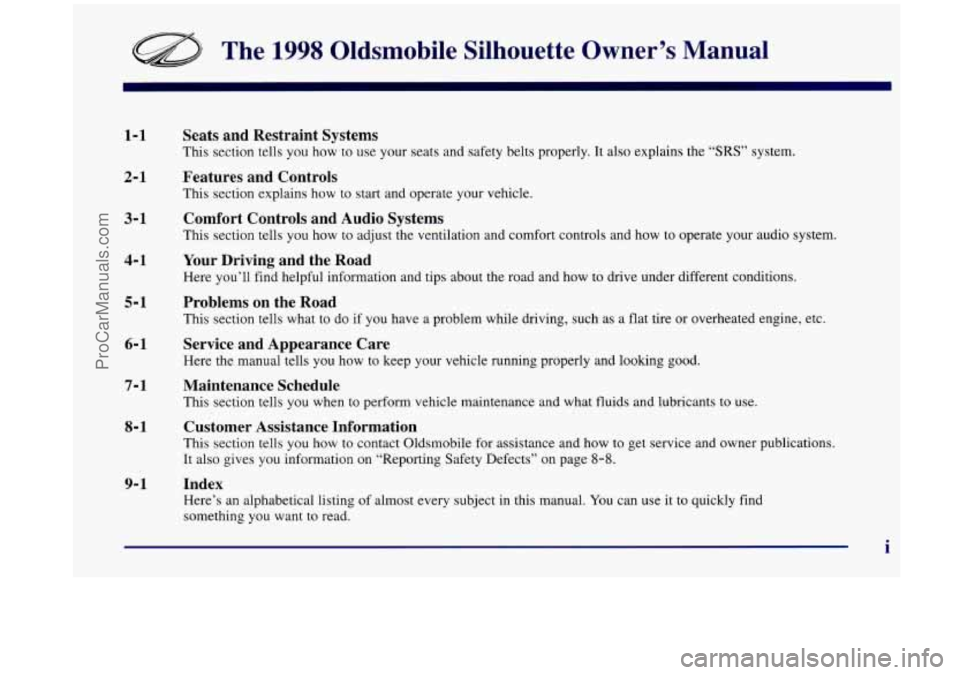
The 1998 Oldsrnobile Silhouette Owner’s Manual
1-1
2-1
3-1
4-1
5-1
6- 1
7-1
8-1
9- 1
Seats and Restraint Systems
This section tells you how to use your seats and safety belts properly. It also explains the “SRS” system.
Features and Controls
This section explains how to start and operate your vehicle.
Comfort Controls and Audio Systems
This section tells you how to adjust the ventilation and comfort controls and how to operate your audio system.
Your Driving and the Road
Here you’ll find helpful information and tips about the road and how to drive under different conditions.
Problems on the Road
This section tells what to do if you have a problem while driving, such as a flat tire or overheated engine, etc.
Service and Appearance Care
Here the manual tells you how to keep your vehicle running properly and loolung good.
Maintenance Schedule
This section tells you when to perform vehicle maintenance and what fluids and lubricants to use.
Customer Assistance Information
This section tells you how to contact Oldsmobile for assistance and how to get service and owner publications.
It also gives
you information on “Reporting Safety Defects” on page 8-8.
Index
Here’s an alphabetical listing of almost every subject in this manual. You can use it to quickly find
something you want to read.
i
ProCarManuals.com
Page 11 of 444
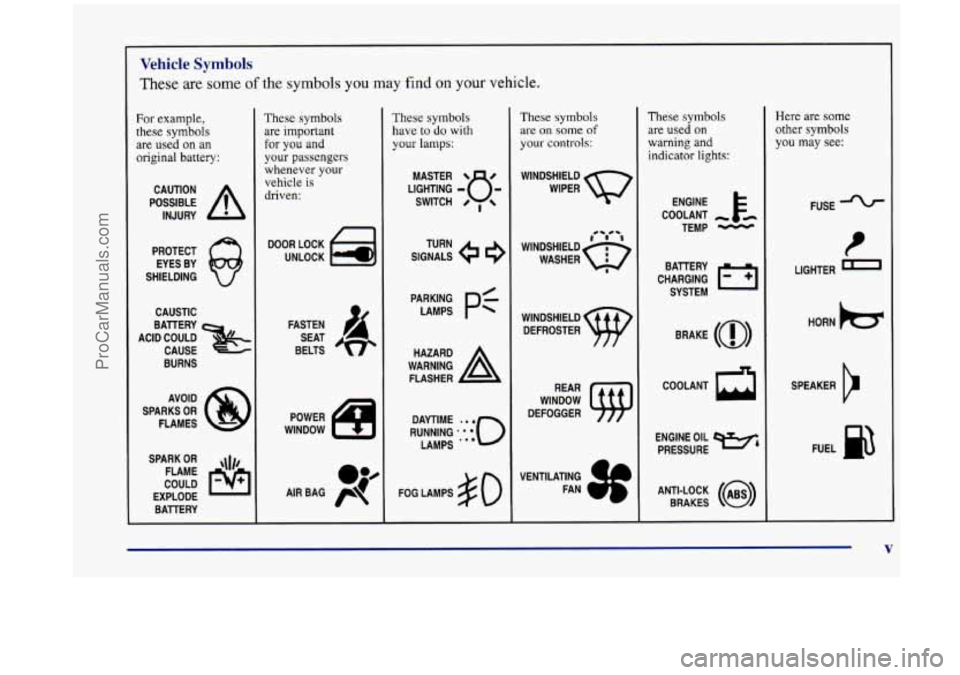
Vehicle Symbols
These are some of the symbols you may find on your vehicle.
For example,
these symbols are used on an
original battery:
POSSIBLE A
CAUTION
INJURY
PROTECT EYES BY
SHIELDING
CAUSTIC
ACID COULD BAllERY
CAUSE
BURNS
AVOID
SPARKS
OR
FLAMES
SPARK
OR ,\I/,
COULD FLAME
EXPLODE BAllERY
These symbols
are important
for you and
your passengers
whenever
your
vehicle is
driven:
DOOR LOCK
UNLOCK
FASTEN SEAT
BELTS
These symbols
have to do with
your lamps:
SIGNALS e
TURN
WARNING
A
HAZARD
FLASHER
FOG LAMPS
$0
These symbols
are on some of
your controls:
WINDSHIELD
WIPER
WINDSHIELD DEFROSTER
WINDOW
DEFOGGER
These symbols
are used on
warning and indicator lights:
ENGINE E*
COOLANT
TEMP
-
CHARGING I-1
BATTERY
SYSTEM
BRAKE
(a)
COOLANT a
ENGINE OIL e,
PRESSURE
ANTI-LOCK
(@)
BRAKES
Here are some other symbols you may see:
FUSE
LIGHTER
m
HORN )cr
SPEAKER
b
FUEL e3
ProCarManuals.com
Page 13 of 444
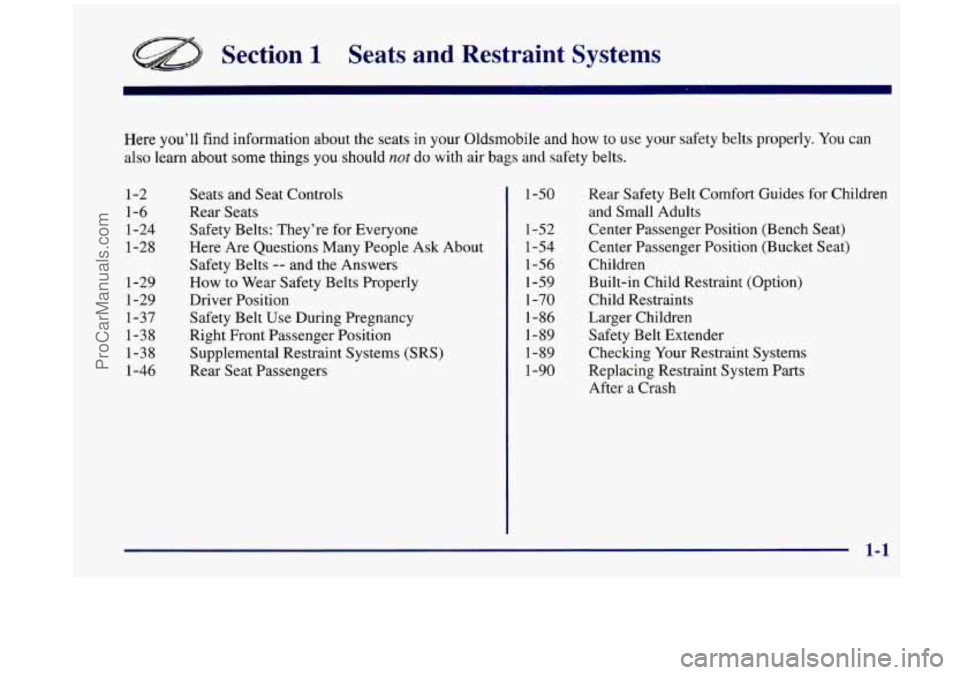
Section 1 Seats and Restraint Systems
Here you’ll find information about the seats in your Oldsmobile and how to use your safety belts properly. You can
also learn about
some things you should not do with air bags and safety belts.
1-2
1-6
1-24
1-28
1-29 1-29
1-37
1-38
1-38
1-46 Seats and Seat Controls
Rear Seats
Safety Belts: They’re for Everyone
Here Are Questions Many People Ask About
Safety Belts
-- and the Answers
How to Wear Safety Belts Properly
Driver Position
Safety Belt Use During Pregnancy
Right Front Passenger Position
Supplemental Restraint Systems (SRS)
Rear Seat Passengers
1-50
1-52
1-54 1-56
1-59
1-70 1-86
1-89
1-89
1-90 Rear Safety Belt Comfort Guides for Children
and Small Adults
Center Passenger Position (Bench Seat)
Center Passenger Position (Bucket Seat)
Children Built-in Child Restraint (Option)
Child Restraints
Larger Children
Safety Belt Extender
Checking Your Restraint Systems
Replacing Restraint System Parts After a Crash
1-1
ProCarManuals.com
Page 17 of 444
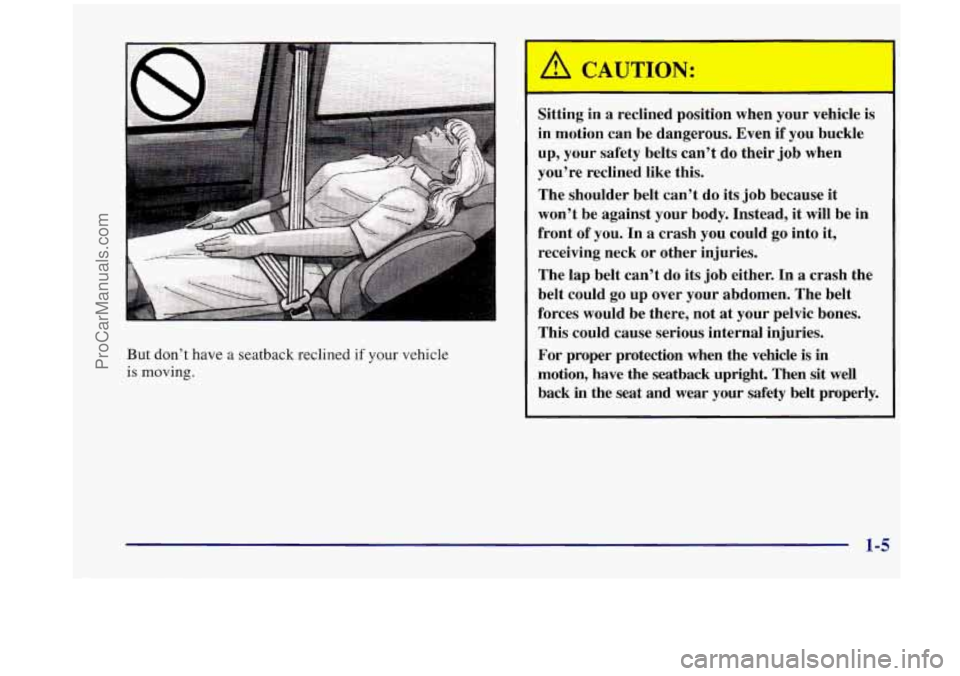
But don’t have a seatback reclined if your vehicle
is moving.
Sitting in a reclined position when your vehicle is
in motion can be dangerous. Even if you buckle
up, your safety belts can’t do their job when
you’re reclined like this.
The shoulder belt can’t do its job because it
won’t be against your body. Instead, it will be in
front of you. In a crash you could
go into it,
receiving neck or other injuries.
The lap belt can’t do its job either. In
a crash the
belt could
go up over your abdomen. The belt
forces would be there, not at your pelvic bones.
This could cause serious internal injuries.
For proper protection when the vehicle is
in
motion, have the seatback upright. Then sit well
back in the seat and wear your safety belt properly.
1-5
ProCarManuals.com
Page 19 of 444
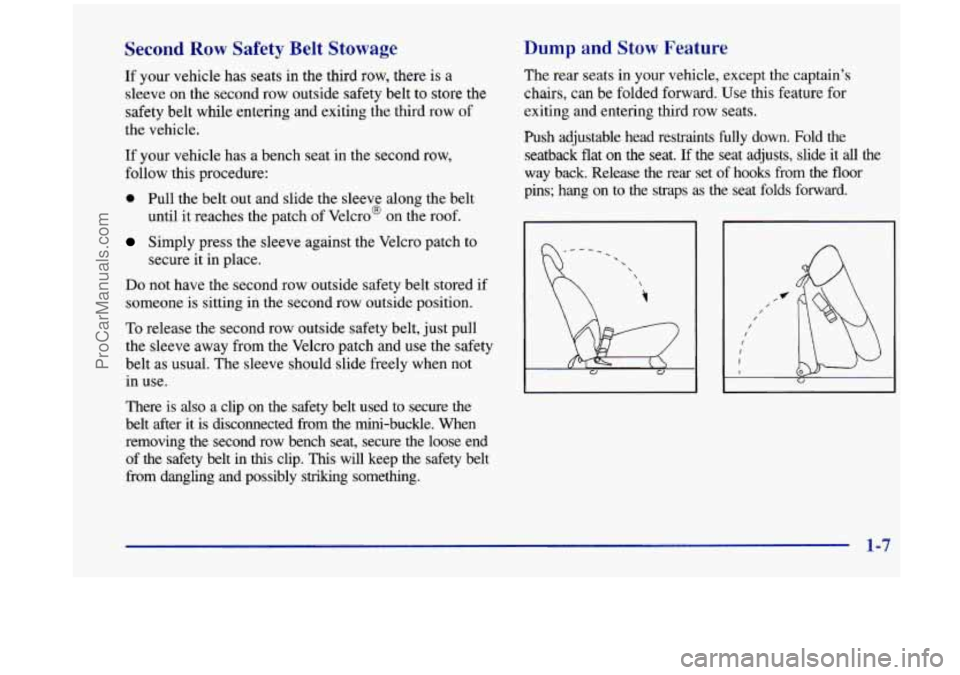
Second Row Safety Belt Stowage
If your vehicle has seats in the third row, there is a
sleeve on the second row outside safety belt to store the
safety belt while entering and exiting the third
row of
the vehicle.
If your vehicle has a bench seat in the second row,
follow this procedure:
0 Pull the belt out and slide the sleeve along the belt
until it reaches the patch of Velcro@ on the roof.
Simply press the sleeve against the Velcro patch to
bo not have the second row outside safety belt stored if
someone is sitting in the second row outside position.
To release the second row outside safety belt, just pull
the sleeve away from the Velcro patch and use the safety
belt as usual. The sleeve should slide freely when not
in use. secure it
in place.
There is
also a clip on the safety belt used to secure the
belt after it is disconnected
from the mini-buckle. When
removing the second row bench seat, secure the loose end
of the safety belt in this clip.
This will keep the safety belt
from dangling and possibly striking something.
Dump and Stow Feature
The rear seats in your vehicle, except the captain’s
chairs, can be folded forward. Use this feature for
exiting and entering third row seats.
Push adjustable head restraints fully down. Fold the seatback
flat on the seat. If the seat adjusts, slide it all the
way back. Release the rear set of hooks from the floor
pins; hang on to the straps as the seat folds forward.
I I I I I U
1-7
ProCarManuals.com
Page 22 of 444

Removing the Split Bench Seat
Make sure the seatback is in the upright position and
that the safety belts
are on the correct section of the seat.
The head restraints should be fully down.
For the second row bench, with the seatback in the
upright position, unhook the side attachment for the
safety belt. This mini-buckle is located on the right side
of the seat.
Push
up the red center on
the buckle with a small
pointed object like a key
or pen.
3. From behind the bench seat, pull the nylon strap at
the base of the seat to release the rear latches from
the floor pins.
4. Do not let go of the straps until the seat is folded all
the way forward.
1. Lift the seatback recliner lever or pull the nylon strap
on the back of the seat to fold the seatback forward.
2. Slide the seat all the way back by lifting either one of
the adjustment bars and sliding the seat fully rearward.
1-10
ProCarManuals.com
Page 26 of 444
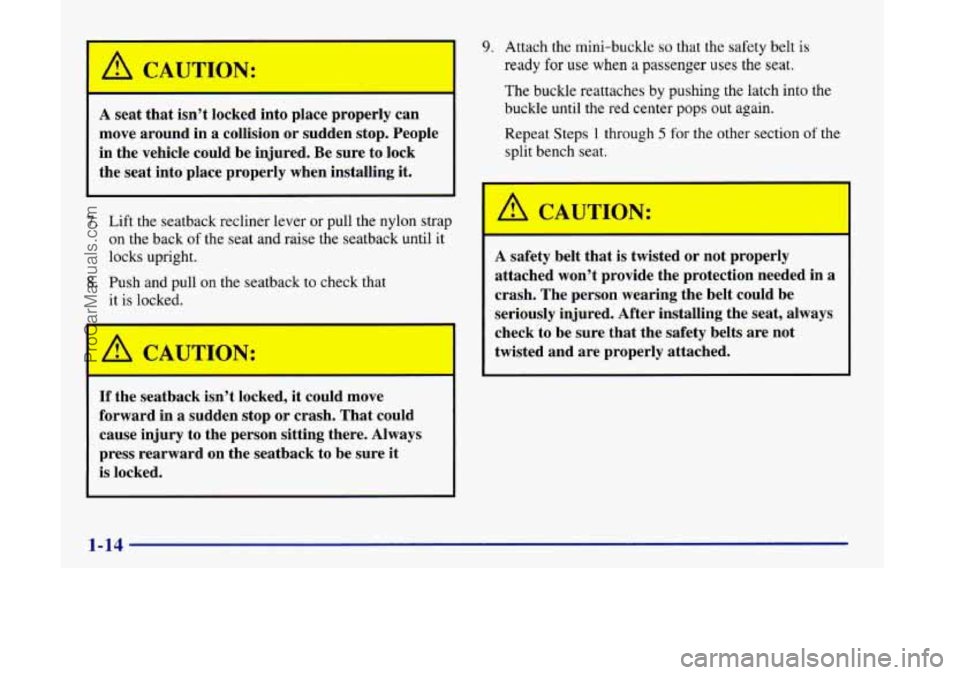
A seat that isn’t locked into place properly can
move around in a collision or sudden stop. People
in the vehicle could be injured. Be sure to lock
the seat into place properly when installing it.
7. Lift the seatback recliner lever or pull the nylon strap
on the back of the seat and raise the seatback until it
locks upright.
8. Push and pull on the seatback to check that
it
is locked.
If the seatback isn’t locked, it could move
forward in a sudden stop or crash. That could
cause injury to the person sitting there. Always
press rearward on the seatback to be sure it
is locked.
9. Attach the mini-buckle so that the safety belt is
ready for use when a passenger uses the seat.
The buckle reattaches
by pushing the latch into the
buckle until
the red center pops out again.
Repeat Steps
1 through 5 for the other section of the
split bench seat.
h CAU dON:
A safety belt that is twisted or not properly
attached won’t provide the protection needed in a
crash. The person wearing the belt could be
seriously injured. After installing the seat, always
1 check to be sure that the safety belts are not
~ twisted and are properly attached.
1-14
ProCarManuals.com
Page 36 of 444
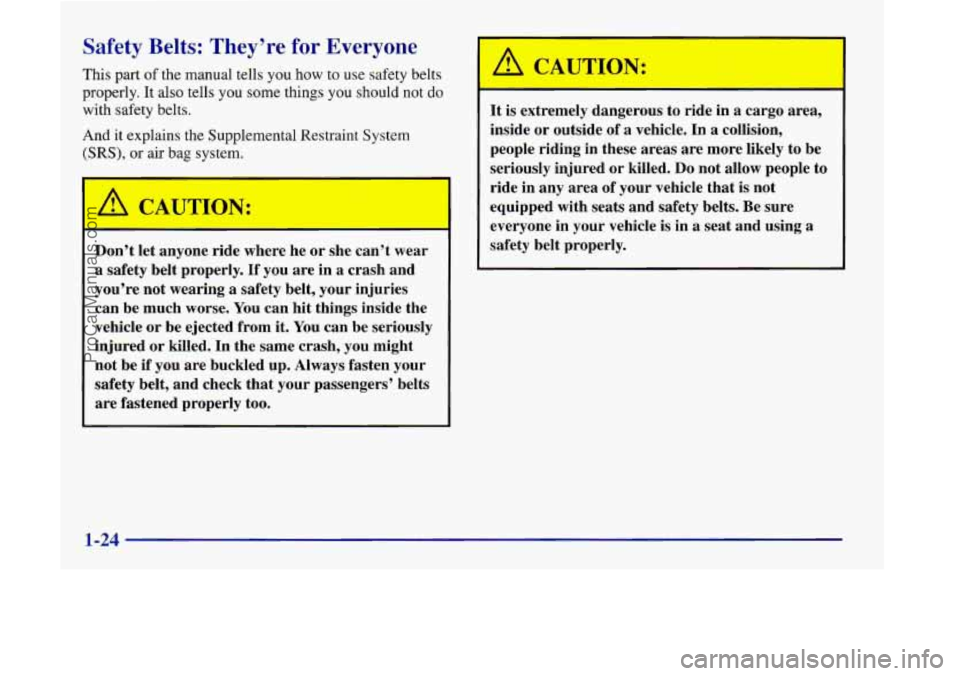
Safety BeT ;: They’re for Everyone
This part of the manual tells you how to use safety belts
properly. It also tells
you some things you should not do
with safety belts.
And it explains the Supplemental Restraint System
(SRS),
or air bag system.
a CAUTION:
Don’t let anyone ride where he or she can’t wear
a safety belt properly. If you are in a crash and
you’re not wearing a safety belt, your injuries
can be much worse.
You can hit things inside the
vehicle or be ejected from it.
You can be seriously
injured or killed. In the same crash, you might
not be if you are buckled up. Always fasten your
safety belt, and check that your passengers’ belts
are fastened properly too.
A CAUTION: ’.
It is extremely dangerous to ride in a cargo area,
inside or outside of
a vehicle. In a collision,
people riding in these areas are more likely to be
seriously injured or killed.
Do not allow people to
ride in any area of your vehicle that is not
equipped with seats and safety belts. Be sure
everyone in your vehicle is in
a seat and using a
safety belt properly.
1-24
ProCarManuals.com
Page 37 of 444
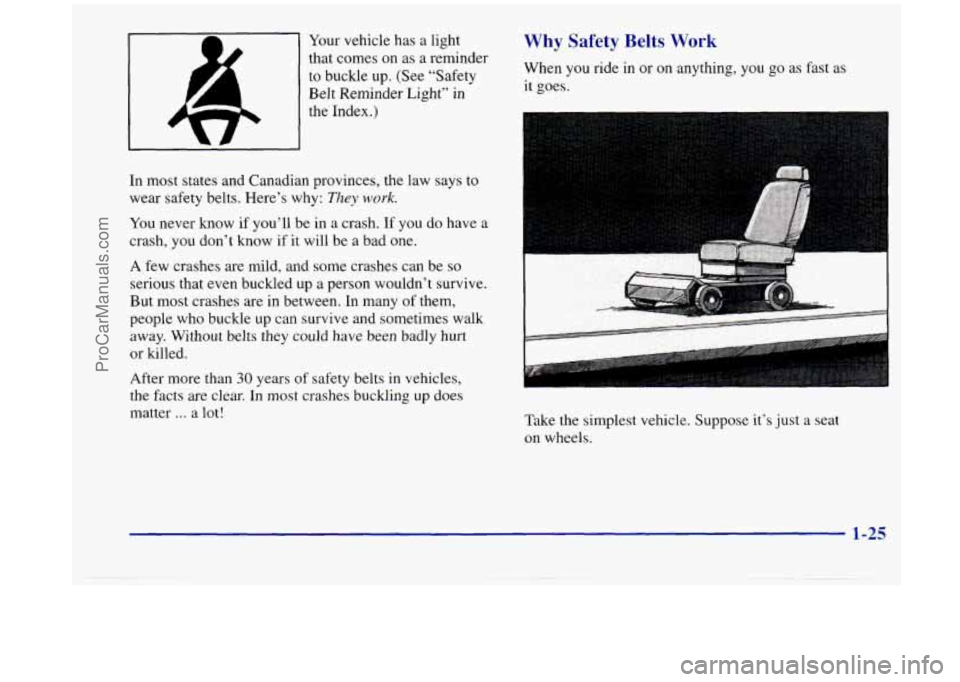
Your vehicle has a light
that comes on as a reminder
to buckle up. (See “Safety
Belt Reminder Light” in
the Index.)
In most states and Canadian provinces, the law says to
wear safety belts. Here’s why:
They work.
You never know if you’ll be in a crash. If you do have a
crash, you don’t know if it will be a bad one.
A few crashes are mild, and some crashes can be
so
serious that even buckled up a person wouldn’t survive.
But most crashes are in between. In many
of them,
people who buckle up can survive and sometimes walk
away. Without belts they could have been badly
hurt
or killed.
After more than
30 years of safety belts in vehicles,
the facts
are clear. In most crashes buckling up does
matter
. . . a lot!
Why Safety Belts Work
When you ride in or on anything, you go as fast as
it goes.
I
Take the simplest vehicle. Suppose it’s just a seat
on wheels.
1-25
ProCarManuals.com
Page 40 of 444

or the safety belts!
With safety belts, you slow down as the vehicle does.
You get more time to stop. You stop over more distance,
and your strongest bones take the forces. That’s why
safety belts make such good sense.
Here Are Questions Many People Ask
About Safety Belts -- and the Answers
Won’t I be trapped in the vehicle after an
accident if I’m wearing a safety belt?
A: You could be -- whether you’re wearing a safety
belt or not. But you can unbuckle a safety belt,
even
if you’re upside down. And your chance of
being conscious during and after an accident,
so
you can unbuckle and eet out, is much greater if
you are belted.
Q: If my vehicle has air bags, why should I have to
wear safety belts?
A: Air bags are in many vehicles today and will be in
most of them in the future. But they are
supplemental systems only;
so they work with
safety belts -- not instead of them. Every air bag
system ever offered for sale
has required the use of
safety belts. Even if you’re in
a vehicle that has air
bags, you still have to buckle up to get the most
protection. That’s true not only in frontal collisions,
but especially in side and other collisions.
1-2s
ProCarManuals.com